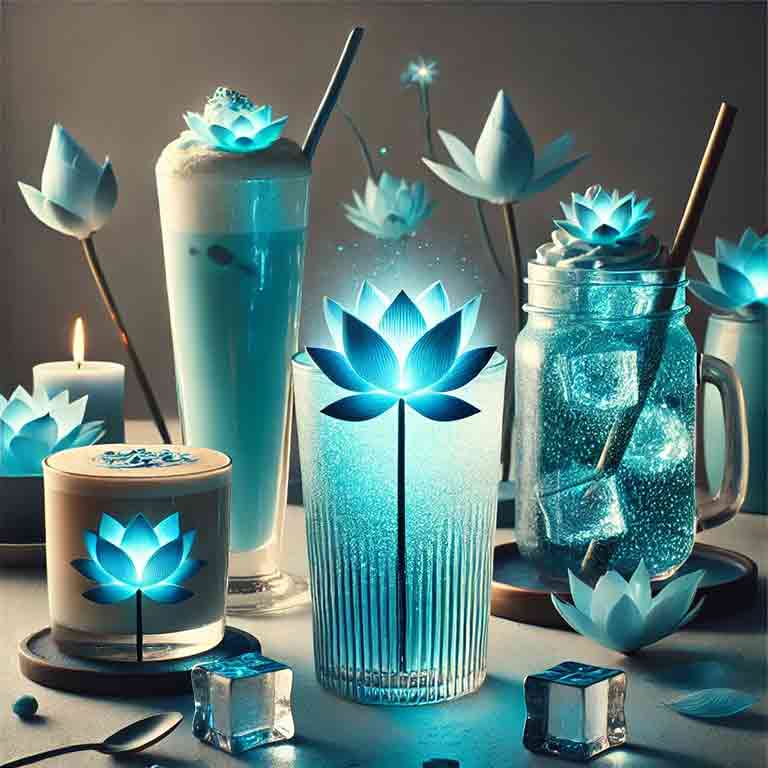The Blue Lotus (Nymphaea caerulea) has captivated civilizations for centuries, celebrated in ancient Egyptian culture for its mystical, spiritual, and medicinal properties. While most people associate it with herbal teas, the modern wellness and beverage industries are pushing boundaries far beyond traditional infusions. From blue lotus cocktails to functional lattes, the versatility of this botanical is reshaping how people consume and experience it.
In this comprehensive guide, we’ll explore how Blue Lotus is revolutionizing beverage trends, its health benefits, innovative drink recipes, and its growing role in the premium functional drink market.
The Rise of Blue Lotus as a Beverage Ingredient
The demand for natural plant-based beverages is on the rise. Consumers are looking for drinks that provide relaxation, cognitive support, and holistic wellness benefits. Blue Lotus fits perfectly into this shift, as it offers:
-
Mild relaxation properties similar to calming teas.
-
Aesthetic appeal, with its rich blue hue.
-
Cultural and historical prestige, linked to rituals and ancient medicine.
This makes it a premium botanical ingredient for both the functional beverage industry and the craft mixology scene.
Blue Lotus Beyond Tea: Expanding the Horizon
1. Blue Lotus Lattes and Elixirs
Coffee shops and wellness cafés are creating Blue Lotus lattes, often blending the extract with plant-based milk, spices like cinnamon, and adaptogens. These drinks are marketed as:
-
Stress-reducing alternatives to coffee.
-
Caffeine-free energy boosters, ideal for afternoon relaxation.
-
Visually stunning creations with a calming blue or violet tone.
2. Blue Lotus Smoothies and Wellness Shots
Blending Blue Lotus powder or extract with fruits, superfoods, and probiotics creates beverages designed for:
-
Gut health support.
-
Mental clarity and mood enhancement.
-
Post-workout recovery and hydration.
3. Blue Lotus-Infused Alcoholic Beverages
The craft cocktail industry is experimenting with Blue Lotus-infused spirits. Bartenders and mixologists are infusing it into:
-
Gin-based cocktails for floral notes.
-
Mezcal or rum creations for exotic, earthy undertones.
-
Sparkling wines infused with lotus essence, marketed as premium celebratory drinks.
4. Blue Lotus Kombucha
The probiotic-rich kombucha market is embracing Blue Lotus for both flavor and wellness benefits. It enhances kombucha’s tangy profile while promoting relaxation, making it a dual-purpose functional drink.
5. Blue Lotus Mocktails and Functional Beverages
As non-alcoholic beverages gain momentum, Blue Lotus is becoming a star ingredient in mocktails. Its natural calming properties and vibrant color give it an edge in the wellness-driven drink category.
Nutritional and Functional Benefits of Blue Lotus Beverages
Consuming Blue Lotus in beverages provides more than just unique flavors. It delivers a functional health profile that appeals to conscious consumers:
-
Mild sedative properties that support stress relief and improved sleep.
-
Potential antioxidant activity, helping combat free radical damage.
-
Mood-enhancing effects, with anecdotal evidence suggesting mild euphoria.
-
Digestive support, especially when combined with probiotic drinks.
Unlike caffeine-based stimulants, Blue Lotus beverages are associated with calm focus rather than jittery energy spikes.
How Brands Are Positioning Blue Lotus Beverages
Wellness and Lifestyle Branding
Health-conscious consumers are seeking beverages that align with mindfulness, relaxation, and holistic living. Blue Lotus drinks are marketed as ritualistic wellness experiences rather than just refreshments.
Luxury and Premium Positioning
Because of its ancient cultural significance and exotic origin, Blue Lotus has found its way into luxury beverages. High-end cocktail lounges and specialty tea houses are elevating their menus with Blue Lotus offerings.
Functional Beverage Industry Adoption
With the functional drink market projected to grow significantly, Blue Lotus is being positioned as a natural nootropic and adaptogen-friendly botanical. Companies are blending it with mushroom extracts, CBD, and superfoods for enhanced functionality.
DIY Blue Lotus Beverage Recipes
Blue Lotus Relaxation Latte
-
1 tsp Blue Lotus extract or powder
-
1 cup almond or oat milk
-
½ tsp cinnamon
-
1 tsp honey or agave
-
Heat milk, whisk in Blue Lotus, add cinnamon and sweetener. Serve warm.
Blue Lotus Sparkling Mocktail
-
½ tsp Blue Lotus syrup
-
Sparkling water
-
A splash of lime juice
-
Garnish with mint leaves
-
Refreshing, non-alcoholic, and uplifting.
Blue Lotus Infused Gin Tonic
-
2 oz gin infused with dried Blue Lotus petals
-
Tonic water
-
Ice and lemon peel garnish
-
A floral twist on a classic cocktail.
Market Potential and Future Outlook
The functional beverage industry is booming, with consumers seeking drinks that combine wellness benefits with unique sensory experiences. Blue Lotus beverages are well-positioned to ride this wave, with strong potential in:
-
Luxury wellness cafés and tea houses.
-
Premium alcohol and mocktail markets.
-
Health food retail, especially in powdered or bottled formats.
As more scientific research validates its properties, Blue Lotus will likely move from niche herbal circles into mainstream wellness culture.
Conclusion
The world of Blue Lotus-infused beverages extends far beyond tea. From lattes and kombucha to cocktails and mocktails, its versatility makes it one of the most promising botanicals in the evolving wellness and functional drink industry. Its unique blend of cultural heritage, calming effects, and visual appeal positions it as a standout ingredient for brands, mixologists, and health-conscious consumers alike.
As beverage innovation continues, expect to see Blue Lotus becoming a defining element of next-generation wellness drinks, offering a bridge between tradition and modern functional luxury.
FAQs
1. What does Blue Lotus taste like in beverages?
Blue Lotus has a naturally mild, floral, and slightly sweet flavor, often compared to chamomile with a hint of anise. When infused into drinks, it adds a smooth, calming undertone.
2. Are Blue Lotus beverages safe to consume daily?
Yes, Blue Lotus is generally considered safe when consumed in moderate amounts. However, it’s best to avoid excessive intake, especially for pregnant or breastfeeding individuals, unless approved by a healthcare professional.
3. Do Blue Lotus drinks make you sleepy?
Blue Lotus has mild sedative properties that can promote relaxation and restful sleep. While it won’t usually cause drowsiness after one serving, many people enjoy it in the evening to wind down.
4. Can Blue Lotus be combined with alcohol?
Yes, Blue Lotus can be infused into cocktails, creating unique floral notes. However, because it has natural relaxing effects, it’s advised to drink responsibly when mixing it with alcohol.
5. Where can I buy Blue Lotus for making beverages at home?
Blue Lotus is available in several forms, including dried petals, extracts, powders, and syrups. You can purchase it from herbal shops, specialty wellness stores, or trusted online retailers.

